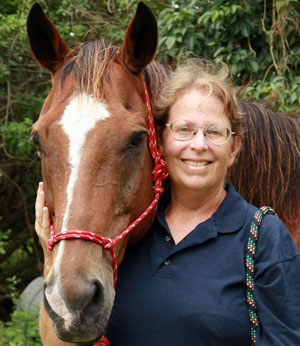TALES FROM THE TRAILS
Mary Ann Simonds has her fingers in many pies, including equine psychology, equestrian life coaching, horse-human interaction, equine horse-play therapy, equine ecology, equine horse-awareness and consciousness, holistic and natural horse care, and wild horse behavioral ecology.
Her career path has ranged from scientist to corporate coach. She has worked as a researcher, educator, author and consultant for more than 30 years in the fields of human and animal behavior, communication, consciousness and ethology. She has lectured in Japan, Canada, Europe and across the United States, and has consulted in Australia, South Africa, France and the Middle East in animal behavior and human-animal interactions. Her work blends the application of science with cultural issues, finding solutions for adaptive cohabitation of people and animals.
Mary Ann currently directs the Institute of Integrated Sciences and the Whole Horse & Equestrian Science Institute, while maintaining a professional practice as a consultant. This summer, she is moving to Wellington full-time. She focuses on stress management in animals and how humans influence animal behavior both in the wild and in captivity.
Outdoor Life and ESPN 2 featured her 22-part series on horse behavior and natural health management. She was appointed by the U.S. Secretary of the Interior to the 1990-92 Wild Horse and Burro Advisory Board. She currently sits on the advisory boards of several organizations, including the International Society for the Protection of Mustangs and Burros, the International Alliance for Animal Therapy and Healing, JustWorld International and Holistic Horse magazine. Regionally, she has served on several task forces and boards concerning wildlife, horses, livestock, animal control, transportation/trails and ecosystem management.
Mary Ann grew up in California showing jumpers. “I was lucky,” she recalled. “I got some great horses that allowed me to show in the top junior divisions. I also got a lot of difficult horses, the ones others couldn’t ride or deal with, and they taught me a lot.”
She also learned things to avoid by watching some trainers. “They were always adding more equipment: harsher bits, draw reins, tighter martingales,” Mary Ann said. “I watched one man hit a horse over the head with his crop. I wondered why he was doing that to a horse with a headache? I finally realized that the man had no idea how the horse felt; he was merely trying to fix what he saw as a disobedient horse throwing his head. I was always able to sense how a horse felt. My later work only validated my observations.”
Mary Ann learned a great deal while studying wild horse herds with the University of Wyoming for research funded by the National Academy of Sciences. She later applied the social behaviors she observed to performance horses.
“When I evaluate a horse, I keep in mind the two things horses most require,” she said. “They have to feel safe and comfortable. All behavior problems derive from these two needs not being met in some way. Anxious horses stress and get ulcers. When they’re physically uncomfortable, their muscles can’t develop properly to succeed in a specific discipline.”
The two most common responses are running to escape fear or pain, or stopping or rearing — shutting down and refusing to go forward, she explained. “Many trainers’ answer is to add more equipment, often harsher or tighter. The answer could be just the opposite, something as simple as loosening a noseband,” Mary Ann said.
She also uses some unusual methods, such as aroma therapy. If a horse has separation anxiety from a buddy, she brushes the buddy, then lets the horse smell the brush and brings it along on the trailer. She has also given angry or aggressive horses a squirt of apple cider vinegar from a spray bottle, triggering a flehmen response, temporarily immobilizing the horse.
Most horse people have seen this, though they may not know what it is. When a horse smells something unusual, he may curl his upper lip and press it to the back of his nose.
This flehmen response increases the flow of air through the nostrils, bringing the scent openings behind the incisors on the upper palette to the olfactory organ.
Mary Ann uses many other modalities as well: acupressure, Chinese medicine, stress management remedies, vibrational therapy, kinesio taping, aroma therapy, light therapy, magnetics and sound/music therapy.
“The rhythms and frequencies of various music affects all animals, who’ve shown preferences and behavioral changes while listening to different music,” she said. “Music can be relaxing and healing, or uplifting and energizing. I’ve conducted music preference studies through the years with horses and used music to enhance the learning of both horse and rider.”
We had an interesting discussion about this last point, as I’ve always known the trick of singing to a nervous horse to help it calm down. I don’t have a great voice, but it doesn’t matter. I’ve found repeating sounds in a soothing tone distracts a horse from something scary. One of my best trotting songs is “Jingle Bells.”
Other services Mary Ann offers include equine assessments (identifying personalities, body suitability, learning style, stress tolerance, social skills and the ability to do specific sports) and solving equine behavioral issues (private consultations to determine why specific behaviors are happening and solve the problems).
She offers a four-week prep course to help acclimate horses mentally and physically to the noises and stresses of a large show. Mary Ann is also available to help anyone with their horse, whether their goal is showing or just having a safe and happy pet.
“Increasing awareness of equine welfare is my passion,” she said. “My goal is to create happy, confident, content horses and riders.”
For more information, call Mary Ann Simonds at (561) 235-3641 or (360) 907-4591, or visit www.maryannsimonds.com.








